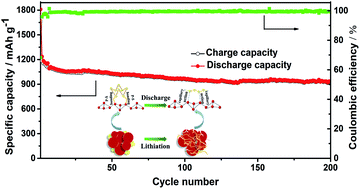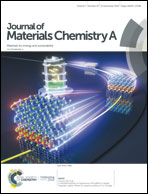A self-healing high-performance phosphorus composite anode enabled by in situ preformed intermediate lithium sulfides†
Abstract
The poor electrical conductivity and large volumetric changes hinder the practical application of red phosphorus despite its high theoretical capacity of 2596 mA h g−1. A simple approach to overcome this challenge via anchoring soluble lithium–sulfur intermediate compounds on the surface of red phosphorus and configuring an efficient interface is proposed here. Sulfur is strategically incorporated into phosphorus by P–S bonding to construct a phosphorus–sulfur/carbon composite with a highly conductive interface. The soluble Li–S intermediates formed during the electrochemical lithiation process could be anchored on the surface of phosphorus by capillary action to heal the cracks/defects of phosphorus caused by volumetric expansion. Calculations based on first principles demonstrate that the strategic introduction of sulfur enables band overlapping near the Fermi level, which facilitates high efficiency electron-transfer at the P–S interface and thus improves the overall electrochemical properties of the constructed composite. Therefore, the phosphorus–sulfur/carbon composite delivers a high initial charge capacity of 1808.2 mA h g−1 at a current density of 200 mA g−1 and maintains a reversible capacity of 935.3 mA h g−1 with a high coulombic efficiency of approximately 99.4% after 200 cycles.



 Please wait while we load your content...
Please wait while we load your content...